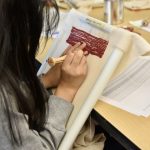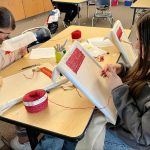Climate change is real, and it’s happening fast. A group of 24 eighth graders at Casey Middle School want adults to accept this as fact.
When these students compared daily high temperatures from Mazatlán, in Sinaloa, Mexico and Boulder, for the years 1923 and 2021, they found significantly warmer results in 2021. For example, in 1923 Mazatlán had many winter days with highs only in the 60s. In 2021 only three winter days were as cool as 60 degrees, and all the others were warmer, including a long stretch of days above 90 degrees, temperatures never recorded in 1923. The data for Boulder showed temperature increases and signs of new variability and temperature extremes–both signals for climate change.
“It’s happening fast…one hundred years isn’t that long,” reflected a student. “It surprised me how the different seasons changed. Summer got longer every year.”
His classmate added, “If we don’t fight against it, it’s just gonna get worse.”
To help people outside their class understand, the students worked in teams of eight for seven weeks and created four “Tempestries” using different colors of yarn to represent the maximum daily temperature data.
One student explained why the group created Tempestries, “Data can be hard to understand in graphs and charts. It’s intimidating. Using art makes it more appealing–easier to notice and see too.”
To create the artworks, students took turns using a punch needle threaded with specific yarn colors corresponding to different temperatures. Some even stayed after school to keep the project on track. They chose Mazatlán to compare to Boulder because of their many family connections and 1923 as their reference year because that is when Casey Middle School was built.
Data for both years in Boulder came from the NOAA National Center for Environmental Information Climate Data Online Search Tool. However, climate records for Mexico from before 1940 do not exist in digitized spreadsheet format. Casey students manually entered daily high temperatures into a spreadsheet by referencing a 100-year-old weather log from Mexico kept on file at NOAA’s Central Library.
Alexandra Rose, education and outreach coordinator for the Niwot Ridge Long Term Ecological Research program (LTER) and CU Science Discovery, initiated the project with Casey as part of the broader impacts for the LTER grant. She worked closely with the students and teachers throughout.
“It’s vitally important that the schoolchildren of today become data-literate adults, able to read graphs and infographics to find patterns and to make meaning and predictions about the future,” said Rose. “These students from Casey have big dreams of creating wonderful lives for themselves and their families. I believe that understanding the gravity of climate change and the threats it poses to their dreams is critical for motivating them to take a stand and be leaders in their communities.”
The Tempestries were displayed at CU Boulder’s Right Here, Right Now Global Climate Summit, and the students attended several summit sessions. CU Science Discovery, the Niwot Ridge Long Term Ecological Research program (Niwot LTER), and Casey Middle School teachers Ian Schwartz, Malinda Hoverstock, Lisa Norton and Kenneth Santiago collaborated, with inspiration from the Tempestry Project, to bring the program to Casey’s AVID program. AVID is a college and career readiness program providing academic, social and emotional support to students with college aspirations. Niwot LTER is funded by the Office for Outreach and Engagement and the National Science Foundation.








